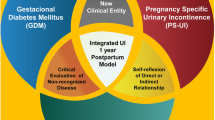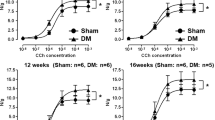Abstract
Introduction and hypothesis
Diabetes mellitus (DM) during pregnancy is associated with high levels of urinary incontinence (UI) and pelvic floor muscle dysfunction. Mild DM can lead to changes in urethral striated muscle and extracellular matrix (ECM) in pregnant rats considering both structures as an entire system responsible for urinary continence.
Methods
Ninety-two female Wistar rats were distributed in four experimental groups: virgin, pregnant, diabetic, and diabetic pregnant. In adult life, parental nondiabetic female rats were mated with nondiabetic male rats to obtain newborns. At the first day of birth, newborns received citrate buffer (nondiabetic group) or streptozotocin 100 mg/kg body weight, subcutaneous route (mild DM group). At day 21 of the pregnancy, the rats were lethally anesthetized and the urethra and vagina were extracted as a unit. Urethral and vaginal sections were cut and analyzed by: (a) cytochemical staining for ECM and muscle structural components, (b) immunohistochemistry to identify fast- and slow-muscle fibers, and (c) transmission electron microscopy for ultrastructural analysis of urethral striated muscle.
Results
In comparison with the three control groups, variations in the urethral striated muscle and ECM from diabetic pregnant rats were observed including thinning, atrophy, fibrosis, increased area of blood vessels, mitochondria accumulation, increased lipid droplets, glycogen granules associated with colocalization of fast and slow fibers, and a steady decrease in the proportion of fast to slow fibers.
Conclusions
Mild DM and pregnancy can lead to a time-dependent disorder and tissue remodeling in which the urethral striated muscle and ECM has a fundamental function.








Similar content being viewed by others
References
Canda AE (2011) Diabetes might adversely affect expression and function of interstitial cells in the urinary bladder and urethra in humans: a new mechanism in the development of diabetic lower urinary dysfunction? Med Hypotheses 76(5):632–4
Barbosa AM, Dias A, Marini G, Calderon IM, Witkin S, Rudge MV (2011) Urinary incontinence and vaginal squeeze pressure two years post-cesarean delivery in primiparous women with previous gestational diabetes mellitus. Clinics 66(8):1341–6
Kim C, McEwen LN, Sarma AV, Piette JD, Herman WH (2008) Stress urinary incontinence in women with a history of gestational diabetes mellitus. J Womens Health (Larchmt) 17(5):783–92
Boncher N, Vricella G, Kavran M, Xiao N, Hijaz A (2012) Setting a new standard: updating the vaginal distention translational model for stress urinary incontinence. Neurourol Urodyn [Research Support, Non-US Gov't] 31(1):190–4
Weber AM, Buchsbaum GM, Chen B, Clark AL, Damaser MS, Daneshgari F et al (2004) Basic science and translational research in female pelvic floor disorders: proceedings of an NIH-sponsored meeting. Neurourol Urodyn 23(4):288–301
Damasceno DC, Sinzato YK, Bueno A, Netto AO, Dallaqua B, Gallego FQ et al (2013) Mild diabetes models and their maternal-fetal repercussions. J Diabetes Res 2013:473575
Marini G, Barbosa AM, Damasceno D, Matheus SMM, Castro RA, Girão MJBC et al (2011) Morphological changes in the fast vs slow fiber profiles of the urethras of diabetic pregnant rats. Urogynaecologia 25(9):31–6
Heesakkers JP, Gerretsen RR (2004) Urinary incontinence: sphincter functioning from a urological perspective. Digestion [Review] 69(2):93–101
Yang JM, Yang SH, Yang SY, Yang E, Huang WC, Tzeng CR (2010) Clinical and pathophysiological correlates of the symptom severity of stress urinary incontinence. Int Urogynecol J [Research Support, Non-US Gov't] 21(6):637–43
Bakircioglu ME, Sievert KD, Lau A, Lin CS, Lue TF (2000) The effect of pregnancy and delivery on the function and ultrastructure of the rat bladder and urethra. BJU Int 85(3):350–61
Li GY, Cui WS, Zhou F, Gao ZZ, Xin H, Liu T et al (2012) Pathology of urethral fibromuscular system related to parturition-induced stress urinary incontinence and TGF-beta1/Smad pathway. Mol Cell Biochem 364(1–2):329–35
Mastrocola R, Reffo P, Penna F, Tomasinelli CE, Boccuzzi G, Baccino FM et al (2008) Muscle wasting in diabetic and in tumor-bearing rats: role of oxidative stress. Free Radic Biol Med [Research Support, Non-US Gov't] 44(4):584–93
Chen B, Yeh J (2011) Alterations in connective tissue metabolism in stress incontinence and prolapse. J Urol 186(5):1768–72
Feldner PC Jr, Kati LM, Sartori MG, Baracat EC, Rodrigues De Lima G, Nader HB et al (2006) Sulfated glycosaminoglycans of the periurethral tissue in women with and without stress urinary incontinence, according to genital prolapse stage. Eur J Obstet Gynecol Reprod Biol 126(2):250–4
Chen CC, Hijaz A, Drazba JA, Damaser MS, Daneshgari F (2009) Collagen remodeling and suburethral inflammation might account for preserved anti-incontinence effects of cut polypropylene sling in rat model. Urology 73(2):415–20
Liapis A, Bakas P, Pafiti A, Frangos-Plemenos M, Arnoyannaki N, Creatsas G (2001) Changes of collagen type III in female patients with genuine stress incontinence and pelvic floor prolapse. Eur J Obstet Gynecol Reprod Biol 97(1):76–9
Mitrano P, Nogueira MD, Feldner PC Jr, Castro RA, Sartori MG, Nader HB et al (2010) Metabolic profile of glycosaminoglycans in bladder and urethra of female rats during and after pregnancy. Int Urogynecol J 21(2):241–6
Sinzato YK, Damasceno DC, Laufer-Amorim R, Rodrigues MM, Oshiiwa M, Taylor KN et al (2011) Plasma concentrations and placental immunostaining of interleukin-10 and tumor necrosis factor-alpha as predictors of alterations in the embryo-fetal organism and the placental development of diabetic rats. Braz J Med Biol Res Rev Bras Pesqui Med Biol Soc Bras Biofisica 44(3):206–11
de Campos KE, Sinzato YK, Pimenta Wde P, Rudge MV, Damasceno DC (2007) Effect of maternal obesity on diabetes development in adult rat offspring. Life Sci 81(19–20):1473–8
Keane DP, O’Sullivan S (2000) Urinary incontinence: anatomy, physiology and pathophysiology. Bailliere Best Pract Res Clin Obstet Gynaecol 14(2):207–26
Kim JH, Huang X, Liu G, Moore C, Bena J, Damaser MS et al (2007) Diabetes slows the recovery from urinary incontinence due to simulated childbirth in female rats. Am J Physiol Regul Integr Comp Physiol 293(2):R950–5
Shek KL, Kruger J, Dietz HP (2012) The effect of pregnancy on hiatal dimensions and urethral mobility: an observational study. Int Urogynecol J 23(11):1561–7
Weidner AC, South MM, Sanders DB, Stinnett SS (2009) Change in urethral sphincter neuromuscular function during pregnancy persists after delivery. Am J Obstet Gynecol 201(5):529, e1-6
Beshay E, Carrier S (2004) Oxidative stress plays a role in diabetes-induced bladder dysfunction in a rat model. Urology 64(5):1062–7
Chen M, Feng HZ, Gupta D, Kelleher J, Dickerson KE, Wang J et al (2009) G(s)alpha deficiency in skeletal muscle leads to reduced muscle mass, fiber-type switching, and glucose intolerance without insulin resistance or deficiency. Am J Physiol Cell Physiol 296(4):C930–40
Baldwin KM, Haddad F (2001) Effects of different activity and inactivity paradigms on myosin heavy chain gene expression in striated muscle. J Appl Physiol 90(1):345–57
Oberbach A, Bossenz Y, Lehmann S, Niebauer J, Adams V, Paschke R et al (2006) Altered fiber distribution and fiber-specific glycolytic and oxidative enzyme activity in skeletal muscle of patients with type 2 diabetes. Diabetes Care 29(4):895–900
Mogensen M, Sahlin K, Fernstrom M, Glintborg D, Vind BF, Beck-Nielsen H et al (2007) Mitochondrial respiration is decreased in skeletal muscle of patients with type 2 diabetes. Diabetes 56(6):1592–9
Kosan M, Hafez G, Ozturk B, Ozgunes O, Gur S, Cetinkaya M (2005) Effect of urothelium on bladder contractility in diabetic rats. Int J Urol off J Jpn Urol Assoc 12(7):677–82
Searls Y, Smirnova IV, Vanhoose L, Fegley B, Loganathan R, Stehno-Bittel L (2012) Time-dependent alterations in rat macrovessels with type 1 diabetes. Exp Diabetes Res 2012:278620
Kirschner-Hermanns R, Daneshgari F, Vahabi B, Birder L, Oelke M, Chacko S (2012) Does diabetes mellitus-induced bladder remodeling affect lower urinary tract function? ICI-RS 2011. Neurourol Urodyn 31(3):359–64
Coletta DK, Mandarino LJ (2011) Mitochondrial dysfunction and insulin resistance from the outside in: extracellular matrix, the cytoskeleton, and mitochondria. Am J Physiol Endocrinol Metab 301(5):E749–55
Acknowledgments
The authors thank the staff of the Laboratory for Experimental Research in Gynecology and Obstetrics, Laboratory of Anatomy and Laboratory of Morphology, especially Talísia Moretto and Gelson Rodrigues, for excellent technical and scientific contribution. We also thank Prof. Dr. Steven Sol Witkin (Cornell University, USA) and Prof. Dr. Firouz Daneshgari and all staff of the Department of Urology (Case Western Reserve University, USA) for excellent technical and scientific contributions. This study was supported by grants from FAPESP/Brazil (Fellowship Process Number 2010/13303-3 and 2012/00099-4) and CNPQ (Process Number 473673/2011-8).
Competing interests
None.
Author information
Authors and Affiliations
Corresponding author
Rights and permissions
About this article
Cite this article
Piculo, F., Marini, G., Barbosa, A.M.P. et al. Urethral striated muscle and extracellular matrix morphological characteristics among mildly diabetic pregnant rats: translational approach. Int Urogynecol J 25, 403–415 (2014). https://doi.org/10.1007/s00192-013-2218-4
Received:
Accepted:
Published:
Issue Date:
DOI: https://doi.org/10.1007/s00192-013-2218-4




